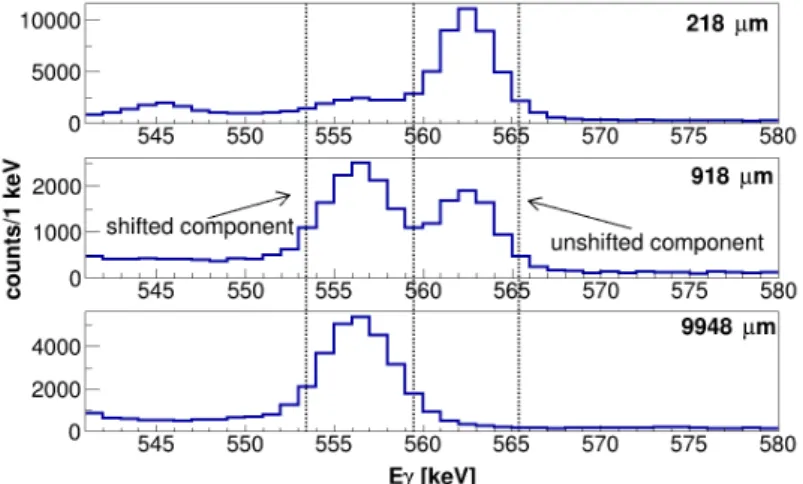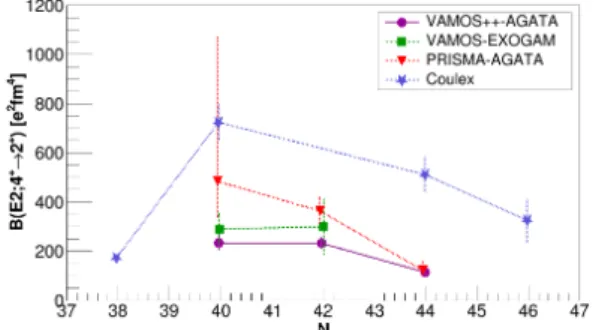HAL Id: hal-02886893
https://hal.archives-ouvertes.fr/hal-02886893
Submitted on 15 Nov 2020HAL is a multi-disciplinary open access archive for the deposit and dissemination of sci-entific research documents, whether they are pub-lished or not. The documents may come from teaching and research institutions in France or abroad, or from public or private research centers.
L’archive ouverte pluridisciplinaire HAL, est destinée au dépôt et à la diffusion de documents scientifiques de niveau recherche, publiés ou non, émanant des établissements d’enseignement et de recherche français ou étrangers, des laboratoires publics ou privés.
Lifetime Measurements of Low-lying States in
73Ga and
70,72,74
Zn Isotopes
T. Milanović, I. Čeliković, C. Michelagnoli, G. de France, A. Boso, T.
Braunroth, E. Clément, A. Dewald, G. Georgiev, E. Ideguchi, et al.
To cite this version:
T. Milanović, I. Čeliković, C. Michelagnoli, G. de France, A. Boso, et al.. Lifetime Measurements of Low-lying States in 73Ga and 70,72,74Zn Isotopes. 36th Mazurian Lakes Conference on Physics, Sep
LIFETIME MEASUREMENTS OF LOW-LYING STATES IN 73Ga AND 70,72,74Zn ISOTOPES∗
T. Milanovića, I. Čelikovića, C. Michelagnolib,c, G. de Franceb A. Bosod, T. Braunrothe, E. Clémentb, A. Dewalde G. Georgievf, E. Ideguchig, B. Jacquotb, W. Królash D. Napolii, N. Lalovićj, K.Y. Leeb, A. Lemassonb, H. Lib
J. Ljungvallf, A. Navinb, A. Norig, R. Pérez-Vidalk M. Rejmundb, P. Ujića, D. Wilmsenb, Y. Yamamotog
M. Zielińskal
a“Vinča” Institute of Nuclear Sciences, University of Belgrade, Serbia bGANIL, Caen, France
cILL, Grenoble, France
dINFN Padova/University of Padova, Italy eInstitut für Kernphysik, Universität zu Köln, Germany
fCSNSM, Orsay, France gRCNP, Osaka, Japan hIFJ PAN, Kraków, Poland iLNL, INFN Legnaro, Italy jLund University, Sweden
kInstituto de Física Corpuscular, CSIC-Universitat de València, Spain lIRFU, CEA, Université Paris-Saclay, Gif-sur-Yvette, France
(Received January 15, 2020)
Lifetimes of low-lying states in73Ga and70,72,74Zn were measured
us-ing the Recoil Distance Doppler Shift (RDDS) method. These nuclei were produced in deep-inelastic reactions in inverse kinematics with a 208Pb
beam impinging on a76Ge target. Prompt γ rays were detected using the
AGATA tracking array coupled to the VAMOS++ spectrometer. Lifetime of the 5/2− state in 73Ga, measured for the first time, provides additional evidence for the existence of a 1/2−, 3/2− ground-state doublet. The life-times of the 4+ states in70,72,74Zn were remeasured in an attempt to
un-derstand the discrepancies observed between earlier measurements. Our results are in agreement with those of previous plunger experiments.
DOI:10.5506/APhysPolB.51.837 ∗
Presented at the XXXVI Mazurian Lakes Conference on Physics, Piaski, Poland, September 1–7, 2019.
838 T. Milanović et al.
1. Introduction
One of the main goals of nuclear structure studies around68Ni is to un-derstand the onset of collectivity when adding or removing particles from this core. In odd-A gallium isotopes, with three protons outside the Z = 28 core, the observed magnetic moment of the ground state (g.s.) in 71Ga re-veals its single-particle (s.p.) nature since it is close to the effective s.p. moment of geff(πp3/2), while for75,77Ga, they indicate a more mixed
config-uration. Contrary to the rest of odd-A gallium isotopes between A = 67 and A = 79, which have a 3/2−g.s., the g.s. spin and parity of73Ga was found to be 1/2−. The fragmented wave function of the 1/2− g.s. in 73Ga, obtained in shell-model calculations, indicates its possible collective structure [1].
Transfer reactions [2–4] indicate that in73Ga, the 3/2−and 1/2− states are close in energy. This suggests the possibility of a 1/2−, 3/2− ground state doublet [5]. A 199-keV transition associated to the 5/2− → 1/2− decay has been observed in a Coulomb-excitation experiment at ISOLDE [6]. The Doppler broadening of this peak indicates that the lifetime of the 5/2−1 state has to be much smaller than 3.5 ns, while the extracted experimental B(E2; 5/2−→ 1/2−) value gives 13(2) ns if it were a pure E2 transition [6]. The presence of a fast component in this transition would further support the existence of a 1/2−, 3/2− g.s. doublet. Diriken et al. [6] suggest an energy difference of < 0.8 keV between these two states, while Vedia et al. [7] give 0.3 keV. Both experiments could only provide an upper limit for the 5/2− state lifetime.
In order to firmly establish and characterize the onset of collectivity in
73Ga, we performed lifetime measurements using deep inelastic reactions.
In addition, low-lying states in 70,72,74Zn were populated, allowing us to measure lifetimes of the first 4+ states, for which strong and systematic dis-crepancy between the Coulomb excitation and plunger measurements exists.
2. Experimental setup
The experiment was performed at the Grand Accélérateur National d’Ions Lourds (GANIL) using the AGATA tracking array [8] coupled to the VAMOS++ mass spectrometer [9]. The nuclei of interest were produced using a deep-inelastic reaction in inverse kinematics with a 208Pb beam at 6.63 MeV/A impinging on a 0.95 mg/cm2 thick 76Ge target deposited on a 1.2 mg/cm2 Cu backing. The nuclei of interest were identified on an event-by-event basis at the focal plane of the VAMOS++ mass spectrometer, used in dispersive mode. VAMOS++ was rotated at 45◦with respect to the beam axis. In coincidence with the detected recoils, the emitted γ rays were de-tected by the AGATA array, consisting of 29 HPGe crystals, in compact configuration, with the detectors placed at 13 cm from the target.
Lifetimes in the picoseconds range were measured by applying the Recoil Distance Doppler Shift (RDDS) method [10] with the use of a differential plunger device developed at the University of Cologne [11]. A 3 mg/cm2 thick Mg degrader foil was mounted at close distance after the target. The purpose of the degrader is to slow down the recoiling nuclei and provide the possibility to measure the difference in the intensity of γ rays decay-ing before (unshifted component) and after degrader (shifted component) as a function of target–degrader distance. In this experiment, six target– degrader distances were used: 119 µm, 218 µm, 918 µm, 2398 µm, 5035 µm and 9948 µm. The relative intensity evolution of the shifted and unshifted components for the 2+→ 0+ transition in76Ge is shown in Fig. 1.
Fig. 1. Evolution of the 2+→ 0+transition peak in76Ge for three different target–
degrader distances: 218 µm, 918 µm and 9948 µm.
The lifetime for the 2+1 state in76Ge is very well-known (25.93 ± 0.29 ps [12]) and we could acquire a large statistics allowing us to validate our method. Our measurements yielded a value of 26.27 ± 0.30 ps, in excellent agreement with the adopted one. For the 4+state, we obtained a lifetime of 3.14 ± 0.06 ps, which is in agreement with the literature values of 2.6(6) ps [12] and 3.2(1) ps [13].
3. Results and discussion
In order to achieve our main goal, confirming the existence of a ground-state doublet in 73Ga, the lifetime of the 5/2− state was determined from the measured intensities of the 199-keV transition (5/2−→ g.s.). The γ-ray energy spectra, showing the 199 keV peak for three different target–degrader distances and the partial level scheme of73Ga obtained using data from this experiment, are presented in the left and right panel of Fig.2, respectively.
840 T. Milanović et al.
Fig. 2. The 199-keV peak for 119 µm, 5035 µm and 9948 µm target–degrader distances (left). Both unshifted and shifted components appear at two target– degrader distances: 5035 µm and 9948 µm. On the partial level scheme of 73Ga (right) obtained from this experiment, transitions for which we were able to obtain lifetimes are marked with a star. Energy spilitting between 1/2− and 3/2− states of < 0.3 keV is taken from Ref. [7].
Both unshifted and shifted components appear only at 5035 µm and 9948 µm target–degrader distances. The lifetime was deduced from these two target–degrader distances by fitting the decay curve with an exponential curve (Fig. 3) and correcting it for the feeding using the standard formula [10]. The measured lifetime of the 5/2− state is 224 ± 24 ps. Corresponding
Fig. 3. Decay curve of the 5/2−→ 3/2−transition in73Ga, obtained from the
inten-sity ratios of unshifted component over the total peak inteninten-sity (Q5/2−,3/2−) on two
reduced probabilities when assuming a pure M1 or a pure E2 transition are B(M1; 5/2− → 3/2−) = 0.018 ± 0.002 W.u. and B(E2; 5/2− → 3/2−) = 640 ± 70 W.u., respectively. The measured E2 strength is beyond typical values for this mass region, further supporting the argument that the decay of the 5/2− state is of dominant M1 nature.
In addition, we were able to extract lifetimes for the 3/2−2 and 7/2−1 states, and limits for the 9/2+ state. Lifetimes of the 5/2− and 7/2−1 states were measured for the first time, while the lifetime of the 3/2−2 state was pre-viously measured as 67(9) ps, using the advanced time delay (ATD) βγγ(t) method [7]. These results are presented in Table I.
TABLE I Measured lifetimes of low-lying states in 73Ga.
Isotop Transition Eγ [keV] τexp [ps]
73Ga
5/2− → 3/2− 199.1 224 ± 24
3/2−2 → 3/2− 218.2 40 ± 14
(7/2−) → 5/2− 452.1 202 ± 68 (9/2+) → (7/2−2) 279.9 33 6 τ 6 180
We have measured the following lifetimes of the 4+states in Zn isotopes:
6.0±0.8 ps (70Zn), 8.3±0.8 ps (72Zn), and 20.8±2.2 ps (74Zn) corresponding
to B(E2; 4+ → 2+) values of 229 ± 30 e2fm4, 226 ± 22 e2fm4 and 111 ±
12 e2fm4, respectively. These results, although pointing to slightly lower collectivity, are in agreement with the ones previously measured using RDDS methods: VAMOS-EXOGAM [14] and PRISMA-AGATA [15], as shown in Fig.4. Systematic discrepancy between the B(E2; 4+→ 2+) values obtained
from the RDDS and Coulomb-excitation measurements [16] is strongest at N = 44.
Fig. 4. Experimental B(E2; 4+ → 2+) values for zinc isotopes around N = 40,
842 T. Milanović et al.
4. Conclusion
Lifetimes of low-lying states in73Ga and70,72,74Zn were measured using the Recoil Distance Doppler Shift method. The lifetime of the 5/2−state in
73Ga was determined for the first time and its value of 224 ± 24 ps indicates
the presence of a strong M1 component in the transition to the ground state, which firmly establishes the ground state as a doublet. Lifetimes of several other low-lying states in73Ga were measured for the first time. More detailed
analysis of these results, and of the nature of low-lying states in odd-A gallium isotopes, is in progress. In the 70,72,74Zn isotopes, the lifetimes of the 4+ states were measured and the results are in good agreement with the previous values measured by the RDDS method. However, in order to resolve the strong discrepancy observed between the B(E2; 4+→ 2+) values
obtained from the Coulomb-excitation and lifetime measurements, a careful γ–γ coincidence analysis for the plunger experiment should be performed.
This project has received funding from the European Union’s Horizon 2020 research and innovation programme under grant agreement No. 654002 and MESTD of the Republic of Serbia under contract No. OI171018.
REFERENCES
[1] B. Cheal et al.,Phys. Rev. Lett. 104, 252502 (2010). [2] G. Rotbard et al.,Phys. Rev. C 18, 86 (1978). [3] M.N. Vergnes et al.,Phys. Rev. C 19, 1276 (1979). [4] G. Rotbard et al.,Phys. Rev. C 21, 2293 (1980). [5] I. Stefanescu et al.,Phys. Rev. C 79, 064302 (2009). [6] J. Diriken et al.,Phys. Rev. C 82, 064309 (2010). [7] V. Vedia et al.,Phys. Rev. C 96, 034311 (2017).
[8] S. Akkoyun et al.,Nucl. Instrum. Methods Phys. Res. A 668, 26 (2012). [9] M. Rejmund et al.,Nucl. Instrum. Methods Phys. Res. A 646, 184 (2011). [10] A. Dewald, S. Harissopulos, P. Brentano,Z. Phys. A 334, 163 (1989). [11] A. Dewald, O. Möller, P. Petkov,Prog. Part. Nucl. Phys. 67, 786 (2012). [12] R. Lecomte et al., Phys. Rev. C 22, 1530 (1980).
[13] M. Doncel et al.,Eur. Phys. J. A 53, 211 (2017). [14] I. Čeliković et al.,Acta Phys. Pol. B 44, 375 (2013). [15] C. Louchart et al., Phys. Rev. C 87, 054302 (2013). [16] J. Van de Walle et al.,Phys. Rev. C 79, 014309 (2009).


